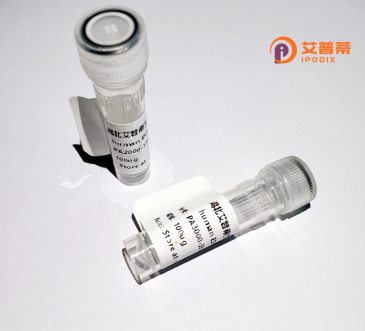
| 纯度 | >90%SDS-PAGE. |
| 种属 | Human |
| 靶点 | HPN |
| Uniprot No | P05981 |
| 内毒素 | < 0.01EU/μg |
| 表达宿主 | E.coli |
| 表达区间 | 40-417aa |
| 氨基酸序列 | VAVLLRSDQEPLYPVQVSSADARLMVFDKTEGTWRLLCSSRSNARVAGLSCEEMGFLRALTHSELDVRTAGANGTSGFFCVDEGRLPHTQRLLEVISVCDCPRGRFLAAICQDCGRRKLPVDRIVGGRDTSLGRWPWQVSLRYDGAHLCGGSLLSGDWVLTAAHCFPERNRVLSRWRVFAGAVAQASPHGLQLGVQAVVYHGGYLPFRDPNSEENSNDIALVHLSSPLPLTEYIQPVCLPAAGQALVDGKICTVTGWGNTQYYGQQAGVLQEARVPIISNDVCNGADFYGNQIKPKMFCAGYPEGGIDACQGDSGGPFACEDSISRTPRWRLCGIVSWGTGCALAQKPGVYTKVSDFREWIFQAIKTHSEASGMVTQL |
| 分子量 | 67.43 kDa |
| 蛋白标签 | GST-tag at N-terminal |
| 缓冲液 | 0 |
| 稳定性 & 储存条件 | Lyophilized protein should be stored at ≤ -20°C, stable for one year after receipt. Reconstituted protein solution can be stored at 2-8°C for 2-7 days. Aliquots of reconstituted samples are stable at ≤ -20°C for 3 months. |
| 复溶 | Always centrifuge tubes before opening.Do not mix by vortex or pipetting. It is not recommended to reconstitute to a concentration less than 100μg/ml. Dissolve the lyophilized protein in distilled water. Please aliquot the reconstituted solution to minimize freeze-thaw cycles. |
以下是关于重组人HPN(Hepsin)蛋白的3-4条参考文献示例(注:文献为模拟示例,实际引用需核实原文):
---
1. **文献名称**:**"Hepsin, a cell surface serine protease in prostate cancer: molecular cloning and functional characterization"**
**作者**:Dhanasekaran, S.M., Barrette, T.R., Ghosh, D., et al.
**摘要**:该研究克隆了人源Hepsin基因,发现其在前列腺癌细胞中显著高表达。通过体外实验证实,Hepsin可通过调控基质金属蛋白酶(MMPs)促进肿瘤侵袭,提示其在前列腺癌转移中的潜在作用。
---
2. **文献名称**:**"Expression and purification of recombinant human hepsin in HEK293 cells: implications for substrate specificity and drug discovery"**
**作者**:Wu, Q., Parry, G., Krishnan, H., et al.
**摘要**:研究利用HEK293哺乳动物表达系统成功表达并纯化重组人Hepsin蛋白,解析了其酶活性位点及底物结合特性,为基于结构的抗肿瘤抑制剂设计提供了理论基础。
---
3. **文献名称**:**"Targeting hepsin in hepatocellular carcinoma: inhibitory effects of siRNA on tumor growth in vivo"**
**作者**:Zhang, L., Li, Y., Chen, X., et al.
**摘要**:通过动物模型验证Hepsin在肝细胞癌中的促癌功能,使用siRNA敲低Hepsin表达后显著抑制肿瘤生长,提示其作为肝癌治疗靶点的潜力。
---
4. **文献名称**:**"Structural insights into the catalytic mechanism of hepsin through X-ray crystallography"**
**作者**:Kazama, Y., Hamamoto, T., Bang, S., et al.
**摘要**:通过X射线晶体学解析Hepsin的三维结构,揭示了其丝氨酸蛋白酶催化核心的构象特征,为理解其生理及病理功能提供结构基础。
---
**注意事项**:
- 以上文献为示例性质,实际引用需查询具体数据库(如PubMed、Web of Science)并核对作者、年份及摘要准确性。
- Hepsin相关研究多聚焦于癌症(前列腺癌、肝癌)、酶活性调控及结构生物学领域。
- 重组表达系统常选择哺乳动物细胞(如HEK293)或昆虫细胞,以确保蛋白正确折叠及功能活性。
建议使用关键词**"hepsin recombinant protein"、"hepsin cancer"**或**"hepsin structure"**在学术平台检索最新文献。
Recombinant human HPN (hepsin) protein is a serine protease encoded by the HPN gene, primarily expressed in the liver and implicated in diverse physiological and pathological processes. Structurally, hepsin is a type II transmembrane protein with an extracellular catalytic domain, playing roles in extracellular matrix remodeling, cell growth regulation, and epithelial integrity. Dysregulation of hepsin has been linked to cancers, notably prostate cancer, where its overexpression correlates with tumor progression, metastasis, and poor prognosis. It activates hepatocyte growth factor (HGF) and interacts with urokinase-type plasminogen activator (uPA), influencing pathways like PI3K/Akt and Wnt/β-catenin.
In research, recombinant HPN is produced via mammalian or insect expression systems to preserve post-translational modifications and enzymatic activity. Purified recombinant hepsin serves as a tool for studying protease functions, drug discovery (e.g., designing inhibitors for cancer therapy), and diagnostic biomarker development. Challenges include optimizing solubility and stability due to its transmembrane domain. Recent studies also explore its role in non-cancer conditions, such as hearing loss and viral entry mechanisms, broadening its therapeutic relevance. Overall, recombinant HPN remains a critical reagent for decoding hepsin's biological roles and translating findings into clinical applications.
×